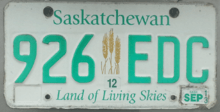Vehicle registration plates of Saskatchewan
The Canadian province of Saskatchewan first required its residents to register their motor vehicles and display licence plates in 1912. Plates are currently issued by Saskatchewan Government Insurance. Only rear plates have been required since June 30, 2004.[1]
Passenger baseplates
1912 to 1976
In 1956, Canada, the United States and Mexico came to an agreement with the American Association of Motor Vehicle Administrators, the Automobile Manufacturers Association and the National Safety Council that standardized the size for licence plates for vehicles (except those for motorcycles) at 6 inches (15 cm) in height by 12 inches (30 cm) in width, with standardized mounting holes.[2] The 1954 (dated 1955) issue was the first Saskatchewan licence plate that complied with these standards.
| Image | Dates issued | Description | Slogan | Serial format | Serials issued | Notes |
|---|---|---|---|---|---|---|
.jpg) |
1912 | White on black porcelain | none | 1234 | 1 to approximately 4500 | |
.jpg) |
1913 | Black on white porcelain | none | 1234 | 1 to approximately 6500 | |
.jpg) |
1914 | Dark blue on yellow porcelain | none | 1234 | 1 to approximately 9000 | |
.jpg) |
1915 | Black on orange flat metal | none | 12345 | 1 to approximately 13500 | |
.jpg) |
1916 | Navy blue on ivory flat metal | none | 12345 | 1 to approximately 18500 | |
.jpg) |
1917 | Red on white flat metal | none | 12345 | 1 to approximately 33000 | |
.jpg) |
1918 | White on green flat metal | none | 12345 | 1 to approximately 54000 | Some later plates embossed. |
.jpg) |
1919–20 | White on black porcelain; provincial shield at left | none | 12345 | 1 to approximately 67000 | Revalidated for 1920 with yellow tabs, for 1921 with red tabs, and for 1922 with green tabs. |
 |
1920–21 | As above, but metal rather than porcelain | 67001 to approximately 82000 | Validated in the same manner as for porcelain plates. | ||
 |
1922 | 12-345 | 82-001 to approximately 97-000 | |||
.jpg) |
1923 | Black on yellow | none | 12-345 | 1 to approximately 62-000 | |
.jpg) |
1924 | White on dark blue | none | 12-345 | 1 to approximately 65-000 | |
.jpg) |
1925 | Black on grey | none | 12-345 | 1 to approximately 68-000 | |
.jpg) |
1926 | White on red | none | 12-345 | 1 to approximately 87-000 | |
.jpg) |
1927 | White on black | none | 12-345 | 1 to approximately 98-000 | |
.jpg) |
1928 | White on green | none | 123-456 | 1 to approximately 104-000 | First use of the full province name. |
.jpg) |
1929 | Black on golden yellow | none | 123-456 | 1 to approximately 109-000 | |
.jpg) |
1930 | White on maroon | none | 123-456 | 1 to approximately 120-000 | |
.jpg) |
1931 | White on purple | none | 12-345 | 1 to approximately 92-000 | |
.jpg) |
1932 | White on blue | none | 12-345 | 1 to approximately 89-000 | |
.jpg) |
1933 | Black on golden yellow | none | 12-345 | 1 to approximately 65-000 | |
.jpg) |
1934 | White on red | none | 12-345 | 1 to approximately 75-000 | |
.jpg) |
1935 | White on brown | none | 12-345 | 1 to approximately 77-000 | |
.jpg) |
1936 | Black on orange | none | 12-345 | 1 to approximately 82-000 | |
.jpg) |
1937 | Black on white | Coronation Year | 12-345 | 1 to approximately 87-000 | Commemorated the coronation of King George VI. |
.jpg) |
1938 | White on red | none | 12-345 | 1 to approximately 89-000 | |
.jpg) |
1939 | Black on orange | none | 12-345 | 1 to approximately 92-000 | |
.jpg) |
1940 | Red on white | none | 12-345 | 1 to approximately 95-000 | |
.jpg) |
1941 | White on red | none | 12-345 | 1 to approximately 96-000 | |
.jpg) |
1942 | Black on orange | none | 12-345 | 1 to approximately 94-000 | |
.jpg) |
1943–44 | Black on white | none | 12-345 | 1 to approximately 89-000 | Revalidated for 1944 with windshield stickers, due to metal conservation for World War II. |
.jpg) |
1945 | Red on white | none | 12-345 | 1 to approximately 98-000 | |
.jpg) |
1946 | White on red | none | 12-345 | 1 to approximately 98-000 | |
.jpg) |
1947 | Black on orange | none | 12-345 | 1 to approximately 98-000 | |
.jpg) |
1948 | Black on silver | none | 123-456 | 1 to approximately 114-000 | |
.jpg) |
1949 | White on brown | none | 123-456 | 1 to approximately 130-000 | |
.jpg) |
1950 | Black on orange | none | 123-456 | 1 to approximately 137-000 | |
.jpg) |
1951 | Black on beige | Wheat Province | 123-456 | 1 to approximately 141-000 | |
.jpg) |
1952 | Beige on black | Wheat Province | 123-456 | 1 to approximately 156-000 | |
.jpg) |
1953 | Green on beige | Wheat Province | 123-456 | 1 to approximately 163-000 | |
.jpg) |
1954 | Beige on maroon | Wheat Province | 123-456 | 1 to approximately 168-000 | |
.jpg) |
1955 | Dark green on white | Golden Jubilee | 123-456 | 1 to approximately 193-000 | Commemorated Saskatchewan's 50 years of provincehood. |
.jpg) |
1956 | White on dark green | Wheat Province | 123-456 | 1 to approximately 192-000 | |
.jpg) |
1957 | Dark blue on beige | Wheat Province | 123-456 | 1 to approximately 195-000 | |
.jpg) |
1958 | Red on reflective light grey | Wheat Province | 123-456 | 1 to 1-000 | Experimental plates. |
.jpg) |
Red on light grey | 1-001 to approximately 201-000 | ||||
 |
1959 | Black on reflective light grey | Wheat Province | 123-456 | 1 to 1-000 | Experimental plates. |
.jpg) |
Black on light grey | 1-001 to approximately 218-000 | ||||
 |
1960 | Light grey on black | none | 123-456 | 1 to approximately 239-000 | |
 |
1961 | Dark blue on white | none | 123-456 | 1 to approximately 248-000 | |
.jpg) |
1962 | White on dark blue | none | 123-456 | 1 to approximately 248-000 | |
.jpg) |
1963 | Dark blue on orange | none | 123-456 | 1 to approximately 261-000 | |
 |
1964 | Green on white | none | 123-456 | 1 to approximately 277-000 | |
.jpg) |
1965 | White on green | Diamond Jubilee | 123-456 | 1 to approximately 287-000 | Commemorated Saskatchewan's 60 years of provincehood. |
 |
1966 | Green on white | none | 123-456 | 1 to approximately 291-000 | |
.jpg) |
1967 | Brown on yellow | Canada Centennial | 123-456 | 1 to approximately 304-000 | |
 |
1968 | Green on white | none | 123-456 | 1 to approximately 311-000 | |
 |
1969 | White on green | none | 123-456 | 1 to approximately 313-000 | |
 |
1970 | Green on reflective white | none | 123-456 | 1 to approximately 308-000 | |
 |
1971 | Red on reflective white | none | 123-456 | 1 to approximately 325-000 | |
 |
1972 | Blue on reflective white | none | 123-456 | 1 to approximately 315-000 | |
 |
1973 | Red on reflective white | Home of the RCMP | 123-456 | 1 to approximately 316-000 | |
 |
1974 | Green on reflective white | none | 123-456 | 1 to approximately 339-000 | |
 |
1975 | Red on reflective white | none | 123-456 | 1 to approximately 365-000 | |
 |
1976 | Blue on reflective white | none | 123-456 | 1 to approximately 383-000 |
1977 to present
Saskatchewan is currently one of three provinces where decals are not used to show that the vehicle has valid registration, the others being Quebec and Manitoba.
| Image | Dates issued | Description | Slogan | Serial format | Serials issued | Notes |
|---|---|---|---|---|---|---|
.jpg) |
1977 – May 1998 |
Green on reflective white with screened wheat graphic | none | ABC 123 | see right | Three-letter series issued in random blocks. Letters I, O, Q, U and V not used; this practice continued until 2009. |
 |
May 1998 – early 2009 |
As above, but with smaller wheat graphic and province name | Land of Living Skies | 123 ABC | 100 AAA to 999 GXZ | Front and rear plates required until June 30, 2004; only rear plates required since.[1] The change occurred in the early 'E' series of serials. |
 |
early 2009 – present | 001 GYA to 429 LWZ (as of July 9, 2020) | Manufactured on aluminium rather than steel, and with former South Dakota serial dies. Letters I, Q, U and V and numbers 001 through 099 added to serials.[3] |
References
- "Saskatchewan moves to a single plate on June 30th". Government of Saskatchewan. June 28, 2004. Retrieved March 22, 2020.
- Garrish, Christopher (October 2016). "Reconsidering the Standard Plate Size". Plates. Vol. 62 no. 5. Automobile License Plate Collectors Association.
- Tanner, Eric N. "Saskatchewan License Plates". allaboutlicenseplates.com. Retrieved June 1, 2016.
External links
| Wikimedia Commons has media related to Licence plates of Saskatchewan. |